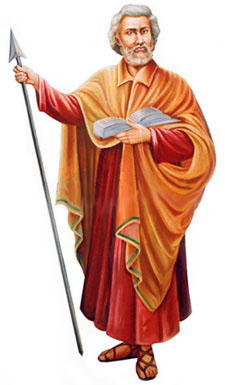 Christianity in India
Christianity in India
Christianity arrived in India with the missionary efforts of Apostle Thomas who is believed to have landed at Kodungallur on the Malabar Coast in AD 52, where the apostle established many Christian communities. He visited different parts of Kerala and converted local inhabitants including many from the upper sect known as Namboodiri Brahmins. It is also believed those St. Thomas established Churches in seven places in Kerala (Kodungallore, Palayur, Paravur, Kokkamangalam, Niranam, Chayal, Korakkeni, Kollam) and a chappal (half church-"Arappalli") at Thiruvankottu. Christian community in Kerala is not a homogenous entity. However most Kerala Christian groups follow certain common practices derived from local cultural influences such as wedding customs, and use of Malayalam language in liturgy. These Christians, known as St Thomas Christians, are the Christians who took root on Indian soil. St Thomas Christians have been carrying this rich and ancient tradition over the last 20 centuries.
Syro- Malabar Church: Origin & History
Indian Christians were not very happy with the Latin jurisdiction and they revolted against the Latin rule. On January 3, 1653, Christians, under the leadership of Thomas Parambil, assembled at Our Lady of Life church, Mattanchery, and pledged that "we will no longer be under the Jesuits." This event is known as the Coonan Cross Oath. On 22 May, 1653, Thomas Parambil was declared the bishop (Mar Thoma I) at Alangad. It caused a division in the church and with this we have the introduction of the Jacobite church in India. Those who continued to be under the Latin jurisdiction remained in the Catholic Church.
Catholics in Kerala continued to be ruled by Carmelites and Jesuits, and had European bishops. In 1896, the church administration was entrusted in the hands of the native bishops. On May 20, 1887, Pope Leo XIII established two Vicariates Apostolic namely Kottayam (areas of today's Changanasserry diocese AND today's Kottayam diocese) and Trichur (areas of today's Trichur diocese AND today's Ernakulam diocese) exclusively for St Thomas Christians, who shortly came to be known as Syro-Malabarese or Syro-Malabar Catholics, and appointed Dr Charles Lavigne (Kottayam) and Dr Adolph Medlycott (Trichur) as Vicars Apostolic. This marked the beginning of the Syro-Malabar Church.
The Catholic Church is the communion of 22 individual or sui juris Churches. There is one Latin Church, and there are 21 Oriental Churches (also called Eastern Churches). All these 21 Oriental or Eastern Catholic Churches are in full communion with the Vatican (the Pope) and the Church of Rome or the Roman Catholic Church, forming the One, Holy, Catholic, and Apostolic Church. India is blessed with three individual Catholic churches: The Syro-Malabar Church and the Syro-Malankara Church (both Oriental churches or Eastern Rite churches), and the Latin Church. The Syro-Malabar Church and the Syro-Malankara Church follow the Oriental tradition; The Syro-Malabar Church follows the East Syrian (Chaldean) tradition and the Syro-Malankara Church follows the West Syrian (Antiochian) tradition.
Knanaya Catholics
In AD 345, there was a Persian migration under the leadership of a Persian merchant by name Thomas of Cana (Knai Thomman or Thomas Kinai) at the behest of the Assyrian Church of the East. Thomas of Cana settled in the southern part of Kodungallur (today's Kottayam) with 72 Jewish Christian families, a bishop, and a few priests and deacons. On August 29, 1911 a new Vicariate Apostolic of Kottayam was erected exclusively for the Knanaya Community by the Apostolic letter “In Universi Christiani” of His Holiness Pope St Pius X. On December 21, 1923 the Vicariate Apostolic of Kottayam was raised to an Eparchy by Pope Pius XI. Descendents of Thomas of Cana are today known as Knanaya Catholics, and they form the Syro-Malabar diocese of Kottayam.